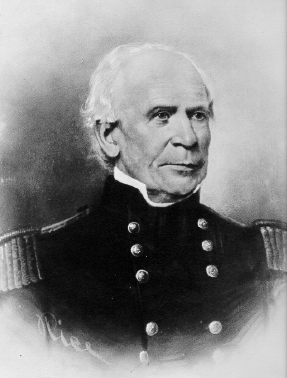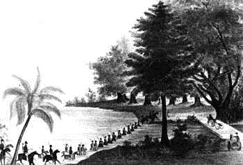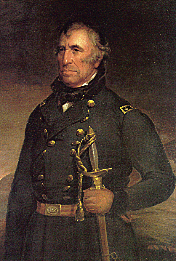
| Map of Florida | Dade's Massacre | 1836 | 1837 | 1838 | 1839 | 1840 | 1841 | 1842 | Home |

January 10th
Gen. Jesup comes upon a village of hostiles and captures 52 Negroes and flushes out a band, supposedly led by Osceola.
Even though Osceola is extremely ill he and three of his followers escape.
January 17th
The local militia out of St. Augustine, corner a band on the Hanson's plantation. In this engagement the Negro leader John Ceasar is
killed.


After realizing that massed armies could chase the small bands of hostile Indians with almost no effect. Gen. Jesup decided to divide his army into small groups and engage the enemy where ever or when ever he found them. He would divide Florida into these areas of operations:
February 3d
Alligator, Jumper, and Micanopy arrive at Fort Dade to parley with U. S. officials about a cease fire. It was decided that they would
return on the 8th and discuss it further.
February 8th
The three chiefs fail to show up at Fort Dade.
While encamped on Lake Monroe, Col. Fannings force was attacked at dawn by King Philip and his son Coacoochee bands. A steamboat
used for patroling the lake was able to come to the forces aid and help drive of the attack with its artillery fire. The men would erect a fort
at this location after the battle and name it for the first man killed in the engagement, Capt. Charles Mellon.
February 9th
Col. Foster's detachment comes upon a village near Crystal River and engages it.
March 6th
The Seminoles and their allies agree to turn themselves in at Fort Brooke and await removal in the area south of the Hillsborough River.
Another stipulation in the treaty allowed those Negroes with the Seminoles and their allies to be relocated with them, this was a focal point
in the Seminoles not wanting to leave the area which was not addresses in the Treaty of Paynes Landing.
April 5th
A boundary line is established from the Hillsborough River due east and an order is given for no whites to cross it.
April 8th
Gen. Jesup and several influential chiefs signed a secret agreement to turn over all slaves that were taken in the war. This would
cause many problems due to the Indians not recording in writing when individuals were taken.
April 18th
At Fort Brooke Yaholoochee's band arrives and turns themselves in. At Fort Mellon the clans of Osceola, Sam Jones, Coa Hadjo, King Philip,
Tuskinia, and Coacoochee arrive.
April 29th
Gen. Jesup writes to a comrade that he believes this is the final days of the war.
May 1st
Whites are given permission to pass the boundary in order to gather their cattle that have strayed into those lands.
End of May
The leaders Micanopy, Alligator, Jumper, Cloud and their bands, are moved from Fort Mellon to Fort Brooke.
June 2d
Osceola, along with Sam Jones, raid the detention camp near Fort Brooke with 500-700 warriors. All supplies are taken and the people there
scatter, sending the territory back into a state of hostilities.
June 11th
In order to boost recruiting in the Creek Nation, for the U. S. Army, the government allows all property taken by them to be kept. On this
date this is extended to all persons in Florida who join the militia. In hopes that they will form up and help out with the war.
June 22d
Gen. Macomb offers to have Gen. Jesup relieved from his command in Florida, but this offer is refused.
July
The Army of Florida's desifnation is changed to the Army of the South.
August
Gen. Gaines makes a move to acquire the command of the Army of the South, but fails to do so.
September
The alliance between the Seminole Confederation and the Negroes in the territory start to break down. A few Negroes come into
various settlements and tell about the hardships of living in the scrub.
September 6th
All ex-slaves captured are ordered to be turned over to the army and await the Secretary of War's decision of what shall be done with them.
September 8th
An ex-slave and his wife enter St. Augustine and agree to lead the army to King Philip's camp, near Dunlawton Plantation. In the engagement
all of the band is captured along with King Philip.
September 9th
Upon successfully capturing King Philip's band the force moved on the village of Yuchi Billy. In the ensuing fight the whites lost one killed
and the Indians suffered the loss of One killed and several wounded. This would by all practical purposes clear the area around St. Augustine
of all hostile bands.
October
Gen. Scott makes an attempt to regain control of the Army of the South but fails to do so.
October 27th
Osceola and his band approach Fort Mellon, under flag of truce, and are captured by the force there. Osceola and Coa Hadjo would be
later sent to Fort Marion (Castillo San Marcos) in St. Augustine and held captive at that place.

The Army of the South would be split into 4 parts and areas of operation would be assigned to each in the following manner:
Colonel Zachary Taylor; was to operate, with the First Infantry Reg't, in the area between Kissimee River and Pease Creek, build a fortification for supplies, and fight the enemy where ever they found them.
Colonel Persifor F. Smith; was to operate, with a Reg't of Louisiana Volunteers, south of Taylor's force near the Caloosahatchee River.
Lieutenant Levi N. Powell, USN; with a combined force of sailors, artillery, and some volunteer infantry he was to patrol the Everglades.
Main Column; To be split into four parts and to drive the enemy into the other groups operating throughout the peninsula.
December 5th - 14th
A delegation of Cherokees come to Florida in hopes to end the hostilities. They were successful in bringing in a few chiefs to talk. While the
group approached Fort Mellon flying a flag of truce they were taken capture. The chiefs Micanopy, Yaholoochee, Tuskegee, Nocose, and
Yaholo are transported to Fort Marion for holding.
December 19th
Colonel Taylor gets permission to seek out the enemy in the Lake Okeechobee area. Chief Jumper and his band turn themselves over to
the army.
December 20th
A band of 26 Indians turn themselves over to Colonel Taylor's force.
December 21st
Col. Taylor erects the fortification, Fort Bassinger as a supply depot for his campaign into the Lake Okeechobee region.
December 25th
The Battle of Lake Okeechobee happens and in three hours results in a humiliating defeat for the army. The U. S. force losses 26 killed and 112 wounded
compared to the Seminoles losses of 11 killed and 14 wounded.
December 28th
During the year, the army's campaign in Florida produced 180 Indians, 600 cattle, and 100 horses captured from the enemy.
December 30th
Fort Christmas, near Orlando, is erected and garrisoned by General Jesup.
| Map of Florida | Dade's Massacre | 1836 | 1837 | 1838 | 1839 | 1840 | 1841 | 1842 | Home |